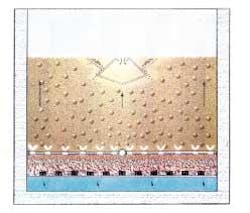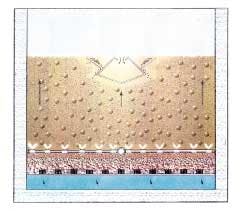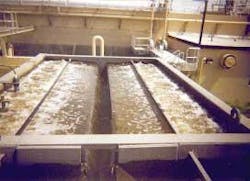Filtration System Minimizes Media Loss, Maximizes Cleaning
By Thomas D. Davis
Baffled troughs that allow operators to take full advantage of the collapse-pulsing action of sustained air/water backwashing can improve filter cleaning and prevent media loss.
One such system, currently being marketed by the Tonka Equipment Co. under the Simul-Wash™ brand name, allows the length of the simultaneous air/water backwash step to be extended beyond the filter's geometric rise limitation. This ability allows operators to control the length of collapse-pulse backwashing for optimum adjustable filter cleaning. It also helps minimize wash water production and prevent mudball formation.
Filter Backwash Research
In the 1990s, filter backwash research was conducted by Amirtharajah, et al, at Georgia Tech under an AWWA Research Foundation (AWWARF) grant. This research was summarized in an AWWARF publication entitled Optimum Backwash of Dual Media Filters and GAC Filter-Adsorbers With Air Scour. The study determined that backwashing filters with simultaneous air plus water at sub-fluidized rates provided improved filter media cleaning.
What was surprising was that using high simultaneous rates of air and water (i.e., water at or near fluidization combined with air) did not significantly increase the amount of debris released from the bed. What showed the best results was simultaneous air and water at sub-fluidized rates, typically water rates on the order of 3 to 5 gpm/sf of filter bed area, coupled with air rates at 2 to 3 cfm/sf. This finding revolutionized the art of filter backwashing.
Collapse-Pulsing Action
A mathematical model was developed by Amirtharajah, et al, to determine the optimum air/water rates, using fluid and soil mechanics theories. This theoretical model was later verified with experimental testing. The most surprising discovery was that under the action of simultaneous air and water, the filter beds undergo a "collapse-pulsing action". The primary variables for attaining this collapse-pulsing action were found to be media gradation and water temperature.
The collapse-pulsing action can be described as follows: the air bubble exits the air delivery device (orifice) and expands under the weight of the media. When the air bubble expands, the media expands slightly within the vicinity of the bubble, and the bubble collapses and re-forms just above its original location. This collapsing is due to the weight of the media. The bubble re-forms above its original location because the media is only partially expanded.
Just prior to collapsing, high local water velocities occur at the perimeter of the bubble. Simultaneous to bubble collapse, media particles rush together and collide in a violent scouring action. This creates a "pulsation" in the bed. The bubble travels on upward, expands, collapses and re-forms again, and repeats the process several times as it passes through the bed. Eventually the bubble reaches the surface and bursts to atmosphere. This collapse-pulsing action was verified using endoscopic video cameras during the latter stages of the research, and appears as a violent pulsation throughout the depth of the media.
Filter Geometry
The only limitation of the AWWARF research was that the time of the backwash was assumed to be limited by filter geometry. Most existing rapid sand gravity filters are designed for water only backwash with maximum 50% allowable room for media expansion below the backwash troughs. This means that to practice simultaneous air and water backwash, water needs to be drained down to 6'' above the surface of the media, air scour applied, and then water introduced simultaneously until the water surface rises to the bottom of the backwash trough. At this point the air must be turned off and water only backwash must commence. If the air is not turned off, media loss will occur. Collapse-pulsing action is so violent that it expands media all the way to the water surface.
Sustained Simultaneous Air/Water Backwash
In the late 1970s research was begun on baffled backwash trough technology suitable for sustained simultaneous air and water backwash. That research led to the development of the baffled trough design offered by Tonka.
The Simul-Wash™ system incorporates a baffled trough that is a low profile design allowing installation into shallow filters. The media-retaining design assures less than 1'' per year media loss under collapse-pulsing backwash conditions.
The trough is fabricated from stainless steel, providing corrosion resistance. Added characteristics of the system include a high moment of inertia for the baffled trough, with the ability to span approximately 23' without requiring intermediate support. This is a key advantage in retrofitting large shallow filter cells with the system..Conclusions
Typical backwash rates include 3 to 5 GPM/sq.ft. of water with air at 2 to 3 SCFM/sq.ft. applied simultaneously. This sub-fluidized water flow rate reduces backwash volume by up to 50% versus conventional backwash systems. Because a re-stratification step is required, a dual rate or variable rate backwash control must be furnished. PLC controls are required to ensure that each filter is backwashed exactly the same way each time backwash is initiated. Maximum water conservation is only attainable when collapse-pulsing action can be sustained.
The Tonka technology also has been incorporated in new pressure filters, and it includes all necessary features of a properly designed sustained simultaneous air/water backwash system for potable water applications.
About the Author:
Thomas D. Davis is President of Tonka Equipment Co., Plymouth, MN. He has over 25 years of professional experience in the potable water treatment industry. A registered professional engineer, Davis holds membership in the American Society of Civil Engineers; the American Waterworks Association; and the Water Environment Federation. For more information, contact Davis via e-mail at [email protected].


